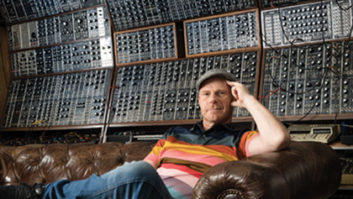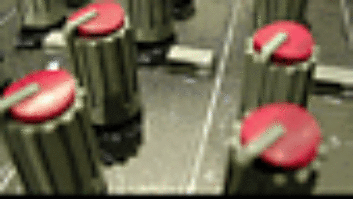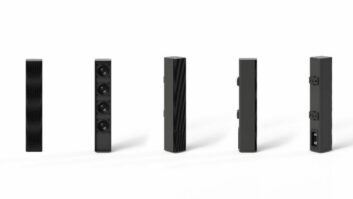
The images are deeply embedded in popular culture: Curtains ofdripping green computer code, Keanu bullet surfing in ultra slow-mo anda gruesome world of ambitious machines gone mad with power. TheMatrix, the 1999 edgy and groundbreaking foray into alternate timeand space, upped the ante for sci-fi, action/adventure andmartial arts movies. It was an amazing feat and an astounding successstory: The Matrix earned more than $458 million in theatersworldwide, sold over 25 million videos and won four Academy Awards. In2003, writer/directors Larry and Andy Wachowski are set to do ittwice, with May’s Matrix Reloaded and MatrixRevolutions in November.
From the start, The Matrix story was envisioned as a trilogy,with Keanu Reeves’ character, Neo — “The One” who cansave the human race — ultimately slated for an epic showdown withthe forces of doom.

Sound in The Matrix kept pace with the stunning visuals,garnering Oscars™ for both Best Sound and Sound Effects Editing.Most of the key players are back onboard, including composer Don Davis,sound designer/supervising sound editor Dane Davis, supervising soundeditor Julia Evershade, sound designer/editor Eric Lindemann and there-recording team at Warner Bros. Somehow, just four days beforeReloaded was due to print master, I was able to nab Dane Davis,Evershade and Lindemann for lunch at Warners. After more than a year ofwork that included nine animated shorts and a sophisticated gamesoundtrack (Infogames’ Enter the Matrix), they wereshell-shocked and weary but also extremely excited.
Although some work began a year earlier, the official start for theproject was in October 2002. It was immediately evident that everythingwas much more complex this time around. “The scale is muchbigger,” says Davis, whose company, Danetracks, has also handledsound for, among other films, Swordfish, 8 Mile and TreasurePlanet. “In addition to expanding on the elements that werealready established — the computer code, the way the guns work,the acoustics of fighting and body movement, and the way time expandsand contracts — there’s also a gigantic freeway chase that’salmost entirely live photography. For the chase, all of the physicalstunts had to be staged, and it had to sound extremely real.”
A major challenge in working with a sequel is to maintain thefamiliar while creating something fresh. The “familiar”sounds of The Matrix resided on 9GB drives; state-of-the-art in1999. Davis and crew faced more than a few hurdles in transferring thatmaterial to today’s systems. Restoring stacks of the old drives to120GB FireWire drives, then reorganizing and “repointing”all of the sessions took months. And then there was that little problemof outdated software. “It was a real pain,” admits Davis.“But we wanted to have all of the components, the whole historyof each sound available to build on.”
Although it references the past, the sonic vocabulary ofReloaded was largely new, even to what Davis calls the fightscene’s body “whooshes” and the signature computer codethrough which the Matrix is entered. “The origins of the soundsare not necessarily the things you think they are,” he explains.“For example, the original code was all made from water drippinginto a barrel. For Reloaded, I made all of the raw codematerials from other kinds of water drips. In the end, we usedvariations of the original code and some more mechanical source sounds.What the characters hear from their monitors had to be very similar toThe Matrix, but what we hear through Neo had to go tomany new places.”
The concept of “big” was important, as in lots of very,very big machines (especially in Revolutions). For some of them,Neumann’s digital Solution-D microphone played a major role. “TheSolution-D was an amazing tool,” notes Lindemann. “For thelarge metal sounds of the machines that are in the real world, werecorded big metal bangs and hits at very high sample rates to captureultrasonic frequencies. That way, we could pitch them down while stillmaintaining the whole harmonic structure.”
“I’m very interested in extreme high frequency, extreme leveland the complexity of the acoustic waveform,” adds Davis.“We do a lot of pitching up and down; generally, when you dothat, you lose a lot of naturalness. The 96k resolution of theSolution-D just happens to play into one of our fascinations: capturingthe harmonics of sounds that we don’t normally hear. We also didextensive recording at 192 kHz using mics with extended upper range,like the Sennheiser MKH800 and some calibration microphones.”
It was the car chase, however, that presented perhaps the biggestrecording challenge. The super, against-the-flow-of-traffic thrillride, filmed on a stretch of freeway that was built on a former navalbase in Alameda, Calif. (for a reported cost of about $2.5 million),was created with very little CGI. Once shot and edited, it wasrelatively complete, making it one of the first scenes ready forDanetracks. Due to the segment’s complexity, six months later, the mixfor those scenes was still being fine-tuned. “It had to beexciting, powerful and fun, in all of the ways that car chases have tobe,” explains Davis. “Except more of it, with cars flippingand tumbling through the air and sword fights on top of the cars. Animportant part of the chase scene was to have it grow dramatically andto avoid ear burnout by the end of the 18 minutes. We all worked veryhard to break the whole scene into many ‘phrases,’ eachwith a different emphasis and feel.”
The process of casting vehicles went on for over two years.“In The Matrix, you can get away with being just a littlemore extreme,” Davis observes, “although we also tried torespect the realistic aspects of, say, a GM vehicle. With some of thecars, the people who built them thought they were ready for racing, butwhen we put them through the range of emotional expression we werelooking for, they blew up. It’s not like we were redlining the wholetime. We didn’t want to blow anything up. We just wanted to findout how angry something could sound.”
Cars were abused in numerous other ways, as well, from crashsessions on a rented speedway to a four-day marathon “cardropping” in a junkyard, complete with crane and 3,500-poundwrecking ball. An array of 14 or so mics — Schoeps, Sennheiser,Neumann and Audio-Technica, among others — was arranged in anarc, with recording helmed by lead recordist John Paul Fasal.
We don’t want to spoil anything, but there are fights inReloaded. For fresh combat sounds, two jujitsu masters werebrought into both the Danetracks facility and Warner Hollywood’s Foleystage to do battle for another microphone array. “The jujitsufighters were amazing,” says Davis. “We recorded themhitting and slugging and kicking each other wearing fabric and leather,and with bare skin. We had them throw themselves into eachother…and down onto the ground on various surfaces. We did it fordays and days, and they got very good at it. Especially when theyunderstood that it wasn’t about the visuals. We didn’t care at all whatthey were doing, only what the mic ‘saw.’”
THE EDIT
Given the tons of new material and vast gigabytes of old material,obviously a major challenge with a workload this huge and detailed isorganization. The system that networks the Danetracks library, serversand databases, and also connects to the dubbing stage, was designedcompletely in-house, although it uses some components from elsewhere,including Decode from Mark Gilbert’s Gallery software. “We callit FIDO,” Davis says with a laugh, “because it hunts,points, barks and fetches. Our design engineer, David McRell, and Iworked on it for over five years. Having that kind of system is theonly way a show of this complexity and schedule compression can bedone. There’s no time for phone calls and long conversations.Everything is in the databases and in terse e-mails.”
For the most part, scenes, though they evolved with visual effects,didn’t change conceptually. “The movie is exactly like thescript,” explains Lindemann. “The directors storyboardeverything, and then they make cartoons called ‘animatics’that are like the pencil drawings on an animated film. A lot of thetime, they do animatics and edit them before they even shoot the realmaterial, so they’re in editing long before they’re done shooting.
“We keep a lot of things virtual in Pro Tools, because thingsare going to change and we know it,” adds Lindemann, who did muchof his sound building in 5.1. “For example, there’s a scene wherethere’s extreme slow-motion gunfire; slower than the one in theoriginal Matrix. The flames coming out of the gun are Jello-y,and the sound is very complicated. It’s very slow, but the shots keepchanging, so there’s no real hard sync as to where the gunshot is oreven what it looks like.
“In that scene, there were something like eight‘mechanical’ layers to a gunshot, and because it’s in slowmotion, sounds that would normally come after the shot come before it.It’s all mixed up to create this unusual sense of time beingmanipulated. It doesn’t make sense on an intellectual level, but whenyou hear it, it feels like something really slow.”
Much of Davis’ work is done by real-time manipulation. He uses twoPro Tools systems (as well as Steinberg’s Nuendo) and records betweenthem using both analog and AES lines. “Some of theplug-ins,” he asserts, “and programs like Metasynth performdifferently when you’re manipulating the preview buttons than they dowhen you use the automation. Working in real time makes it more of aperformance: I get more emotional expression sculpting the variableslive while it’s a continuous stream of audio. For the same reason, Iuse a MIDI controller for other sounds. It’s all about energy anddramatic intensity: the ‘physicality.’ A lot of sounds thatwe create, like for the ships and for the Sentinels [the squid-likemachines that come and attack the humans], are combinations: They’reaudio samples and MIDI sequencing, with lots and lots of MIDIautomation on top of lots of Pro Tools real-time automation controllingplug-ins.”
All of that is ultimately in pursuit of not the literalrepresentation of a sound, but its essence. “We are much moreinterested in the dramatic and emotional reality of something,”says Davis. “What is a sword? It’s death, pain, damage,sharpness. We did tons of recording, we had swords built to ourspecifications with holes drilled in them for mounting, and we foundall kinds of other things that would help create that sound of sharp,painful, dangerous steel. We suspended all these swords and fake swordsand got them clanging and spinning really fast in the air, thenrecorded it all HD at 192k so we could slow things down as much as wewanted to [and still keep the upper edge of the sound]. But what reallymatters is the expressiveness and the emotional connection with theaudience.
“As with the fight hits and the whooshes, it’s not about thepoint of contact,” Davis continues. “When somebody isswinging a fist toward you, it’s about the amount of force that’sbehind that fist and about the damage you’re going to incur. Weexpanded that concept into the sword fighting. The blade coming towardyou doesn’t make much of a sound in real life. But we don’t care,because you feel it. Your brain is going, ‘Sharp, sharp,sharp!’ We made the sound of that sharp coming at you.”
THE MUSIC
“We approach what we do very musically,” says Davis.“Take, for example, the fights, which Julia cuts from the tons ofhits and whooshes I make. These are choreographed fights…and youhave to maintain that ballet. Music is also scored to the fight actionand to that rhythm. It’s all part of the score. It’s all just to giveit a kind of groove.”
The musical groove was the domain of composer Don Davis (not relatedto Dane, although after five movies together, including Bound, Houseon Haunted Hill and The Matrix, they’re some kind offamily!). He started working at about the same time as the sounddesigners, and premixes of music and effects sequences were sent backand forth. “We have a kind of sibling rivalry going for thebandwidth,” comments Dane Davis, “but we know that,ultimately, cooperation and alternation of emphasis are what the movieand the directors need.”
Don Davis also worked to merge the musical aspects of TheMatrix trilogy. “There’s definitely a thematic continuitythat I was attempting to preserve with all three pictures,” heobserves, “and I approached Reloaded somewhat like thesecond movement of a three-movement symphony. The directors felt verystrongly that there should be an electronica element to the score asthere was in the first Matrix, but they wanted to integrate muchmore between the electronica and orchestral elements. I worked veryclosely with Ben Watkins, an artist with a band called Juno Reactor.There were two key sequences that we wrote together: the freeway chase,and what we refer to as the ‘burly brawl,’ the big fightbetween Neo and the multiple-replicated Agent Smith.
“Fortunately, we have a film editor, Zach Staenberg, who isnot only a master, but also very organized, so there is a minimum ofconfusion about changes. Also, his cuts are very musical. Another thingof note is that we delivered everything as a 5.1 spread. I think thatcontributes tremendously to the final product. I don’t like to bring instereo stems of this and that. If everything is conceived from theget-go from a surround standpoint, it’s all going to meshbetter.”
THE MIX
The original Oscar-winning team of John Reitz, Dave Campbell andGregg Rudloff (dialog, music and effects, respectively) was back againfor the final mix of Reloaded. Final FX predubbing began atWarner Bros.’ Stage 6 with Rudloff accompanied one at a time by DeanZupanzic, Ron Bartlett, Steve Pedersonor and Dan Leahy. Concurrently,Reitz and Campbell were predubbing dialog, Foley and backgrounds nextdoor on Stage 5. While the whole Danetracks library system is wired andaccessible to the dubbing stage, in general, a prebuilt stereo or 5.1sound is given to the stage.
“When the sounds leave here, they’re often composited,”comments Davis. “There’s no way we could go to a stage with thethousands of separate details in the many layers of sound we take tothem. We rarely give any ‘choices.’ We make it work, and ifit doesn’t, we do something differently. We don’t like to burden mixerswith a whole bunch of options within the predub units. Even then, theyhave lots and lots of mixing to do.”
“Every one of us has to remain alive to makeRevolutions, so in spite of the stress, the atmosphere was atense kind of fun,” Davis concludes. “[Producer] Joel[Silver] kept us supplied with Polish deli sausages, and vitamins andchili dogs kept our strength up. We had just enough time to makeseveral passes through the entire movie, which made a big difference byallowing for fine- and then finer-tuning as the visuals evolved closerto their ultimate form. By the last day of print mastering, we had aconfirmation of the timing of every VFX shot so we could finallybreathe! I couldn’t feel any sense of completion until I saw those lastfew shots.”
100 SMITHS FIGHT NEO
Julia Evershade, martial arts maven: “Because of the lengthand the intensity of the ‘burly brawl’ sequence, weconcentrated on keeping the sounds as diverse as possible, keeping itrhythmic and real, while trying to vary the sound and speed of the‘whooshes’ and hits as much as possible.
“We knew the sequence would be a big music cue, so Dane had tocreate a pipe hit and swinging whoosh sound with harmonics that wouldcomplement, and not conflict with, the score. These pipe whooshes andclanks then had to be edited so the end result would be harmonious, yetdistinct enough to be recognizable for what they were supposed torepresent.”
CAR DROPPING
Dane Davis: “It was all about the angles that things wouldbounce. We had to drop the cars right in the middle of the microphonearray, and then keep them from rolling over the mics or overall of us. We also had a couple of wrecking balls — including onethat weighed 3,500 pounds — that we dropped through the cars. Atone point, one of the balls went all the way through the cars, throughthe concrete under them, into the dirt and back up through the car,then rolled over a bunch of mic cables and came to rest on a PZM mic,completely crushing it. We got some really great sounds out ofthat.”
THE CODE
Eric Lindemann: “The original code was all water dropping.Then the structures of gears and mechanisms are made of code until theyappear real to people jacked into the Matrix. There are other sceneswhere we needed to take a natural sound and give it a code-like textureas a transitional bridge into code. A good example was the sound of afork passing through a piece of chocolate mousse cake, which Neo seesas code, but also had to sound somewhat natural. This began with asuspended fork clang elongated by grain cycling through a prototypeprogram called ‘Inertia.’ It continued with the Foleyrecording of the fork cutting into cake stretched by a program calledMetasynth. Finally, the full code character takes over, then gives wayto the onscreen woman’s subtle vocal reaction to the experience of thebite of cake.”
THE SENTINELS
Dane Davis: “The Sentinels had to be very monstrous-sounding,very alive and very lethal; yet we know that they’re machines. Each onehas eight motor and gear tracks, plus about four Foley tracks that aredone live [mostly for the tails]. Each track is a composite of a bunchof sounds, and every move that the Sentinels make has to be expressedin every one of those tracks. The dubbing mixers then had to carefullypan each element of each Sentinel as they moved through space to givethem a very real, three-dimensional power and menace.”
WHOOSH!
Dane Davis: “A really key part of the sound of TheMatrix is the way air is pushed out of the way. The whooshes arethe power: all those molecules of air being moved out of the way sothat fist or foot can connect with you in a bad way. It’s unlike a lotof Hong Kong movies that go ‘thuk’ — with no air. Theway we approach it is that every limb is a combination of differentwhooshes. They’re very complicated, with a lot of sound manipulation,but they all start out with real sounds: me swinging things around myhead as hard as I can — computer cables, phone cords, unravelednylon rope, lots of odd things on the ends of rope — you name it,we flung it.”
NIOBE’S FIREBIRD
Andy Lackey, who oversaw vehicle recording: “Niobe is thekiller driver; when she drives, it has to sound pretty ferocious. Afterauditioning over a dozen cars, we found a ‘66 Nova that had beenrebuilt as a dragster with a small-block 355 sprint car racing engine.The car originally had a Flowmaster exhaust system that contributed aringy, sheet-metal quality to the exhaust sound. This was bad. Welistened to various exhaust systems and, based on our requests, [stuntdriver/race car owner] Steve Rowe assembled the exhaust on the Novaspecifically to suit our needs. It sounded great, and the short pipesallowed us to mount our mics in close, out of the wind. We blew it upon the first recording session, so Steve had to rebuild it for thesecond run. This car’s engine and exhaust combo were ferocious and yetvery agile. While doing onboard recordings, we hit 130 mph!”
SPECS — 1966 Nova
Engine:
- 350 Turbo with 12.5:1 compression
- Previously used in a sprint car
Drivetrain:
- 4:8:8 gear ratio, 9-inch Ford rear end
Exhaust System:
- 3.5×36-inch Glasspack system with a 3-inch turndown
- Hooker SuperComp headers

Action! Bonus images from the film
Hang on! Not one but two Matrix sequels are due out this year. Photo by Melinda Sue Gordon

You think this ride was rough? 14-mic arrays captured autos beingdropped from cranes and pummeled with wrecking balls, to nail theperfect crunching metal effects. Photo by Melinda SueGordon

Getting key “whooshing” fight sounds involved swinging around computercables, phone cords and rope.
Photo: Jasin Boland

Many sounds were layered before going to the stage; “hair” layers,however, came from a different department. CourtesyWarner Bros.




